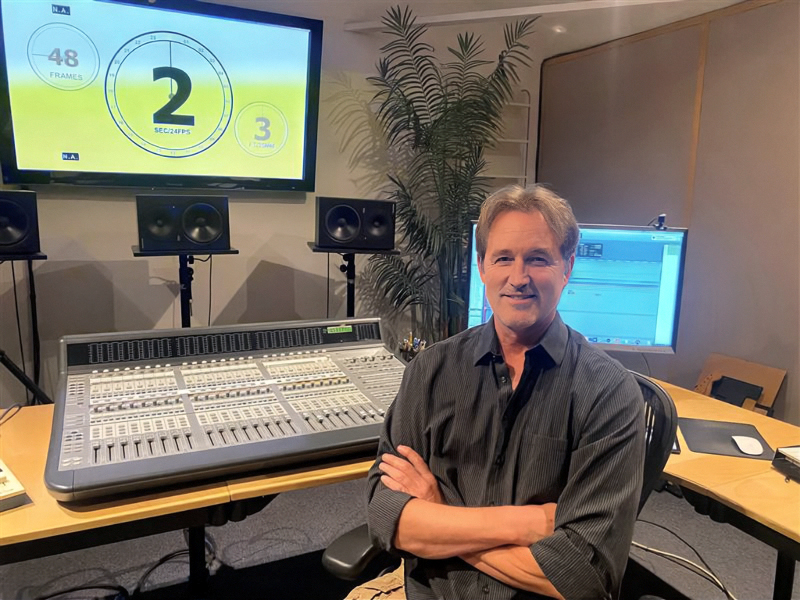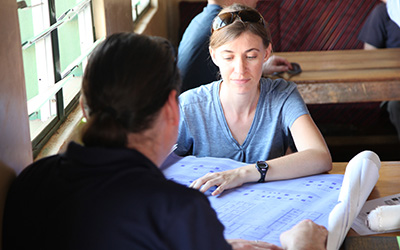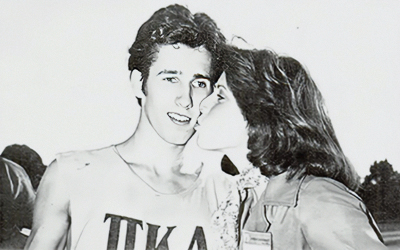Postproduction sound designer, Scott Sanders, has been making noise in Hollywood for
nearly four decades
By Kaitlyn McCarthy

Scott Sanders ’86 spends his days mixing sounds and adding audio effects to big-name films like “The Perks of Being a Wallflower,” “Rambo” and “Halloween.”
At 9 years old, his teacher recommended he get an instructional book on the basics of playing guitar written by legendary guitarist and studio musician Tommy Tedesco. When he opened the book, the first lesson he read said, ‘So you want to be a guitar player? Well, you have to move to where the work is. You have to move to where they play guitar.’
“I was 9, and I remember reading that just thinking how ridiculous that sounded. But it truly is what I ended up doing,” said Sanders.
Years later, Sanders left home to attend Auburn University where he learned important life skills like how to be an effective communicator, how to budget his time and how to be successful in the postgraduate world.
“I think I grew a lot in the four years I was at Auburn. It showed me how to be independent and gave me some very important fundamental skills that maybe I was lacking.”
As soon as he received his telecommunications degree from Auburn, Sanders packed up his life, planted roots in Los Angeles and began a new chapter.
His goal hadn’t wavered since his 9-year-old self began playing guitar. He wanted to be a rock star. Sanders’ plan was to drive to LA, play some guitar and become part of the music scene. It seemed like a pretty simple checklist.
When he landed his first job at Cherokee Studios, a premier studio in LA, he came in each day ready to learn, although he wasn’t quite sure what he was supposed to be learning. His shifts started at midnight and went until 8 a.m. cleaning the bathrooms and studios.
“I cleaned the pee up from some of the most famous people in the world and some of the most prolific artists there are,” Sanders joked. “That’s my claim to fame.”
Many recording sessions would wrap up well after midnight, and Sanders had to wait until each session was done before entering the studio to clean. This left plenty of time for him to observe the sound engineers as they worked.
“Everyone there is trying to become something in the music industry, to work their way up the ladder, and most of the engineers there knew that was the case with me. They would invite me into the studio and show me what they were doing, and it was an amazing education for me,” said Sanders.
Sanders got promoted to an assistant engineer and made enough connections in the industry to work as a sound engineer and musician at various studios throughout the 1990’s, amassing a huge number of credits and building his resume.
“Music sessions would typically start around 9 in the evening and go until 8 in the morning. It was just crazy hours. So [postproduction] was attractive to me at the time—I’d be out of there by 8 o’clock. So off I went into my postproduction adventure.”
In the early 2000s, he shifted his focus from music, and Sanders and his friend Perry Robertson decided to start their own postproduction sound company called EarCandy.
Life Behind the Soundboard

His partner Robertson does the dialogue side of the editing process, while Sanders does the sound effects, completing scenes by adding noises to them after they’ve been filmed.
“Say you’re watching a scene at a lake, and you’re hearing birds, and you’re hearing some wind, and there’s a storm way off in the distance with thunder. Someone jumps in the lake and there’s a big splash,” said Sanders. “That’s all been added afterwards, and that’s what I do.”
Sanders uses sound to further amplify the emotion being conveyed through the story and make viewers feel as though they’ve been transported into the scene.
EarCandy operates out of a house in Los Angeles that Sanders and Robertson converted into a studio. The bedrooms have been converted into editing suites, and Sanders’ studio is a detached garage.
Sanders has a library of millions of sound files that he has collected over the years. The library program on his computer keeps his sound clips categorized, making it easy for him to find specific sounds he may need while editing. He always has an ear for something that sounds interesting or has potential.
“I always have a small recording system ready, or even just my iPhone, and if something sounds good and it might be useful, I’ll record it,” Sanders said. “I will say, though, at this point in my life there’s not much that I really need to record anymore. Because just about everything I ever need I have. It’s pretty crazy, the amount of sounds that I have now.”
With Robertson on dialogue and Sanders on sound, the duo quickly turned EarCandy into one of the premier sound studios in LA.
From Oscar winning movies like “Ray” to box office hits like “17 Again,” Sanders has worked on over one hundred movies and television shows at EarCandy. He recalls working in 2004 on “Ray” as the first time he truly saw, “how to start traveling down that path of doing sound design and what it took.”
In addition to his career successes, he has also worked on his fair share of flops.
“I’ve worked on a lot of stinkers, man, and a lot of times you can tell that [it] is awful, and you know it’s just a paycheck. But quite often you also know when you’ve got something really special,” said Sanders.
One of those incredibly special films he worked on was the 2007 film “Juno.” Sanders and director Jason Reitman mixed each sound themselves in his small studio. As Reitman’s first film, it had a low budget, making it easy for Sanders to include personal touches.
“’Juno’ was one of those films when we first watched it, we were like, ‘Oh, this is going to be special’.”
The film not only ended up being meaningful to Sanders and his team at EarCandy, but it also had a deep connection to his family. There’s a moment in the film when Juno receives an ultrasound. As the doctor performs the ultrasound, the viewer can see it on the screen.
“My wife and I had done an ultrasound, and they used that for the ultrasound in the movie. The ultrasound is actually my son before he was born,” Sanders said.
His son even received his own credit in the film as “Ultrasound Baby.”
“There’s more of a personal connection on those lower budget films where there’s a ‘we’re in the trenches together’ feeling,” said Sanders. “We’re working towards something, and the movie is really good. Those are my favorite kinds of movies.”
A Seasoned Vet
“At this point in my career it’s always interesting because I’ll scan through the TV and almost always, at literally any time of the day, there’s something I’ve worked on somewhere. It’s pretty crazy,” said Sanders.
He has been in the EarCandy studio nearly every day for 22 years now and has learned how to budget his time to prioritize family and hobbies. “It can consume all of your time if you let it.”
However, all the long nights and hard work didn’t come without the fun parts too.
“In the early days, you could hide audio underneath other audio and get away with it. It was a fun underlying challenge to hide sounds of things, like a fart or a chicken, under other sounds like an explosion to see if anyone would notice. I enjoyed those kinds of things.”
Sanders loves his career and has enjoyed getting to have a life outside the studio playing guitar and watching his son grow up. Now that the writers’ strike in Hollywood is over, he’s excited to get back to work on his next project.
“I’m just now getting back to work, and it’s been really nice,” Sanders said. “I feel very fortunate to have gotten where I am. It’s been a very good, long career.”
Building Hope: Disaster Relief Architecture & Design
Combining faith and design, disaster response architect Sarah Elizabeth Dunn ’03 builds shelters for disaster-stricken communities around the world.
Harold Franklin Reflects on Integration 50 Years Later
Fifty years ago, unsure of his safety, a tall, soft-spoken Black man walked alone across the Auburn campus to register for classes.
Auburn Love Stories: How They Met
From blind dates to football games to chance meetings in the classroom, Auburn alums reflect on how they found love and everlasting romance on the Plains.
Building Hope: Disaster Relief Architecture & Design
Combining faith and design, disaster response architect Sarah Elizabeth Dunn ’03 builds shelters for disaster-stricken communities around the world.
Harold Franklin Reflects on Integration 50 Years Later
Fifty years ago, unsure of his safety, a tall, soft-spoken Black man walked alone across the Auburn campus to register for classes.
Auburn Love Stories: How They Met
From blind dates to football games to chance meetings in the classroom, Auburn alums reflect on how they found love and everlasting romance on the Plains.


